QCAA Physics Unit 3 & 4
1/99
There's no tags or description
Looks like no tags are added yet.
Name | Mastery | Learn | Test | Matching | Spaced |
|---|
No study sessions yet.
100 Terms
The Problem of muon decay
The observation that even though muons only have a average life-span of 2.2 microseconds and the expected amount of muons to decay in a 1.91km journey, which would have taken 6.4 microseconds, would have been 527 out of the original 563, however in practice only 154 decayed.
Frame of reference
An arbitrary set of axes with reference to which the position or motion of something is described or physical laws are formulated
Relative motion
Motion where it is based off an observer's frame of reference. An object may be going at 10m/s to on observer stationary to earth, but only 5m/s to a observer riding their bike.
Theory of special relativity (short)
A theory that all motion must be defined relative to a frame of reference; Motion is completely dependent on the frame of reference the observer is in.
Inertial frame of reference
A non-accelerating frame of reference where Newton's laws of physics still hold.
The two postulates (assumptions) of the theory of special relativity
1. The Laws of physics are still the same in all inertial frames of reference.
2. That the speed of light in a vacuum, c, has the same value in all inertial frames of reference
Simultaneity
the relation between two events assumed to be happening at the same time in a frame of reference
Relativity of simultaneity
Two events that are simultaneous in one frame of reference are not necessarily simultaneous in another frame of reference
Proper time interval (t zero, t')
The time an observer at rest relative to an event; An observer on a moving bus is at rest to the bus.
Relativistic time interval (t)
The time an observer moving relative to and event; An observer sitting at a bus stop as a bus drives by is moving relative to the bus.
Time dilation
The difference in the time interval between then same event as measured by two observers moving relative to each other; The time interval changing as the observer at rest to the event experiences speeds near light speed.
The equation for time dilation
Where:
t' = proper time
t = relativistic time
v = velocity of object
c = speed of light (3*10^8 m/s)

Proper length (L zero, L'
The length measured by an observer at rest relative to a event; An observer on a moving bus is at rest to the bus.
Relativistic length
The length measured by an observer moving relative to a event; An observer sitting at a bus stop as a bus drives by is moving relative to the bus.
Length contraction
The shorter length measured by an observer at rest to a object moving at near light speeds; The length measured by an observer relative to a moving object at near light speed shortening.
Length contraction equation
Where:
Lo = proper length
L = relativistic length
v = velocity
c = speed of light
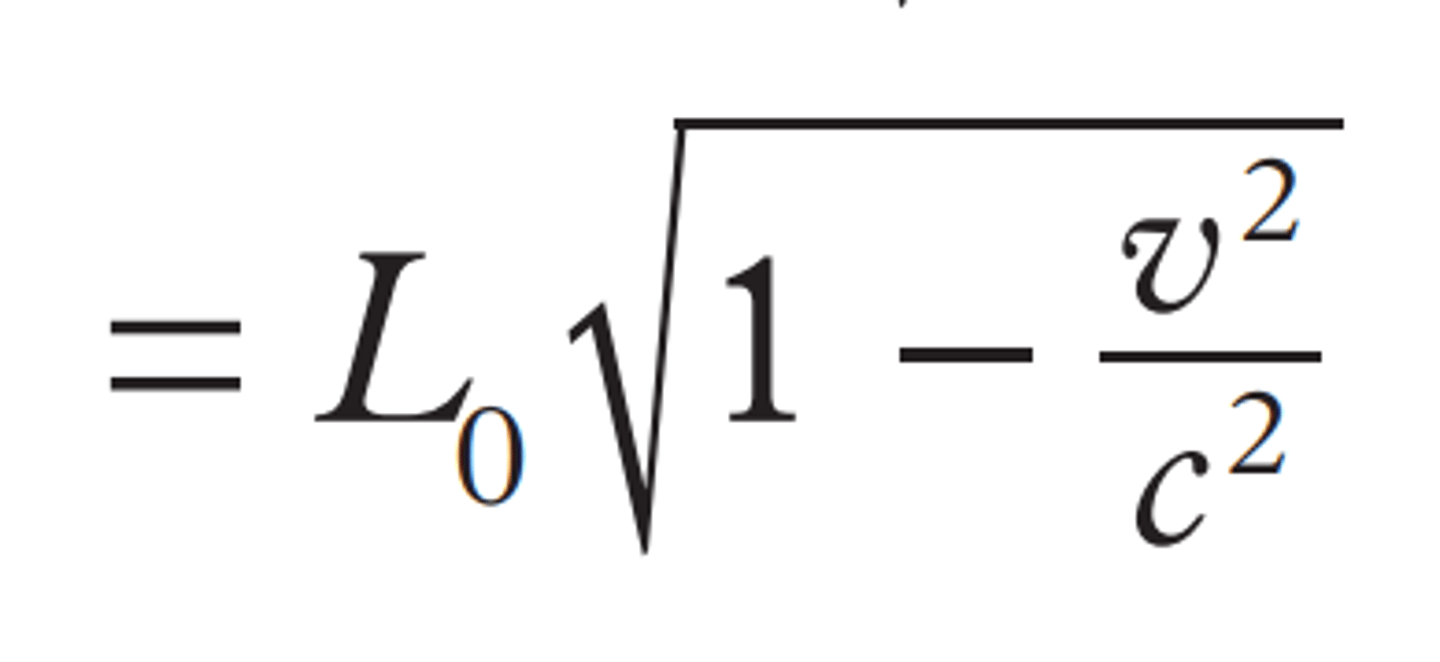
Light-year
A unit of distance, the distance traveled by light in a vacuum in one year (9.5*10^15m).
Rest mass
The mass of an object when measured in the same frame of reference as the observer.
Relativistic momentum
The momentum measured by an observer moving relative to an event; An observer sitting at a bus stop as a bus drives by is moving relative to the bus.
Conservation of momentum
A collision between two objects, will retain the same total momentum after the collision.
mass-energy equivalence
The conversion between mass and energy; E=mc^2.
The reason why the speed of light cannot be exceeded or reached
As the graph shows, to increase a particles speed to light speed would require an infinite amount of momentum, as the speed of light is like an asymptote, unreachable.
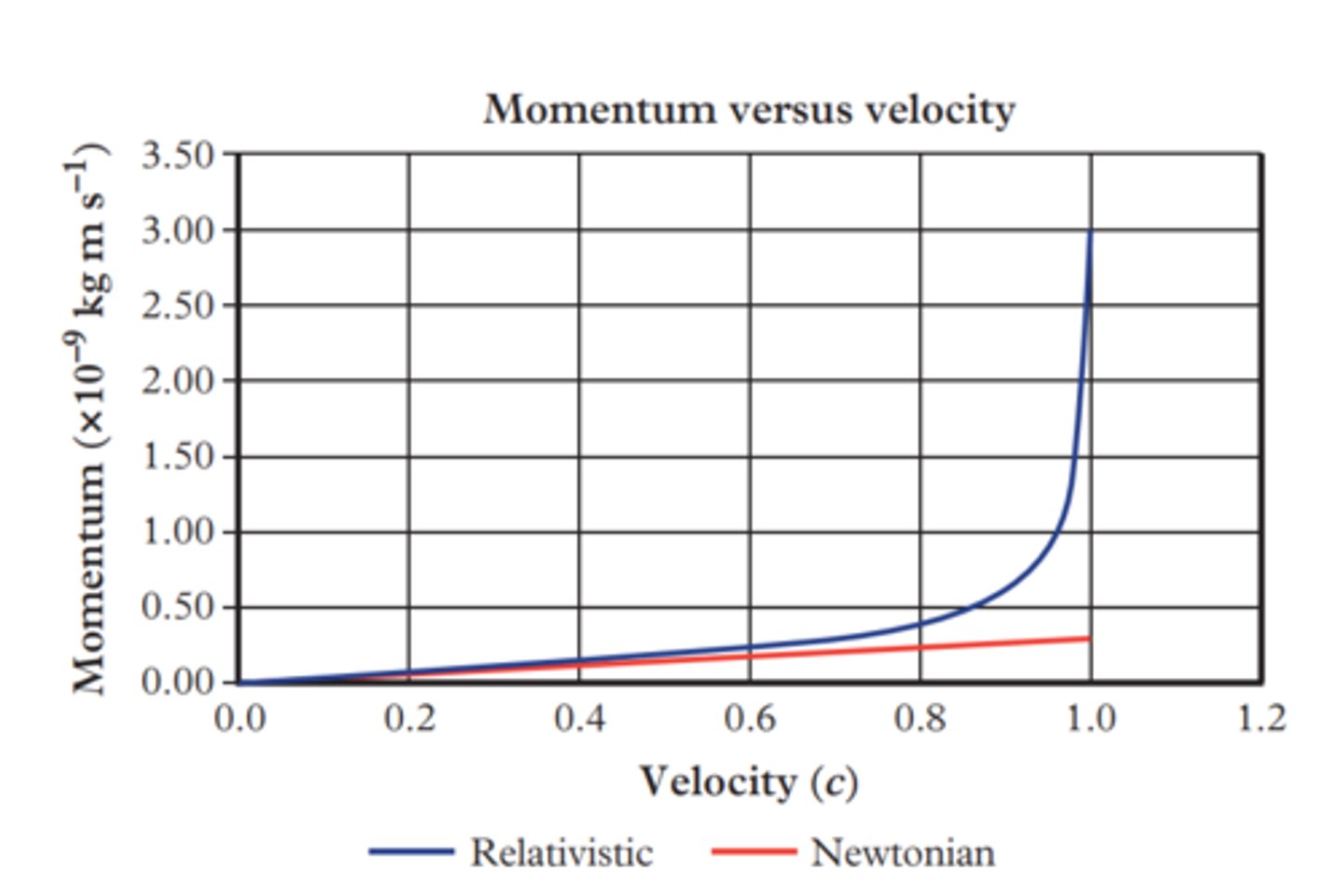
Young's double slit experiment
One light source which shines through to identical slits side by side, into a dark box. The results of this show a series of light 'dots' inside the box. This phenomenon displays the constructive and destruction interference occurring as the light 'beams' collide. The presence of interference confirms that light does not only display properties of particles, but also wave like properties.
Electromagnetic wave
A wave produced by the oscillation of an electric charge, which radiates out at the speed of light as perpendicular electric and magnetic waves.
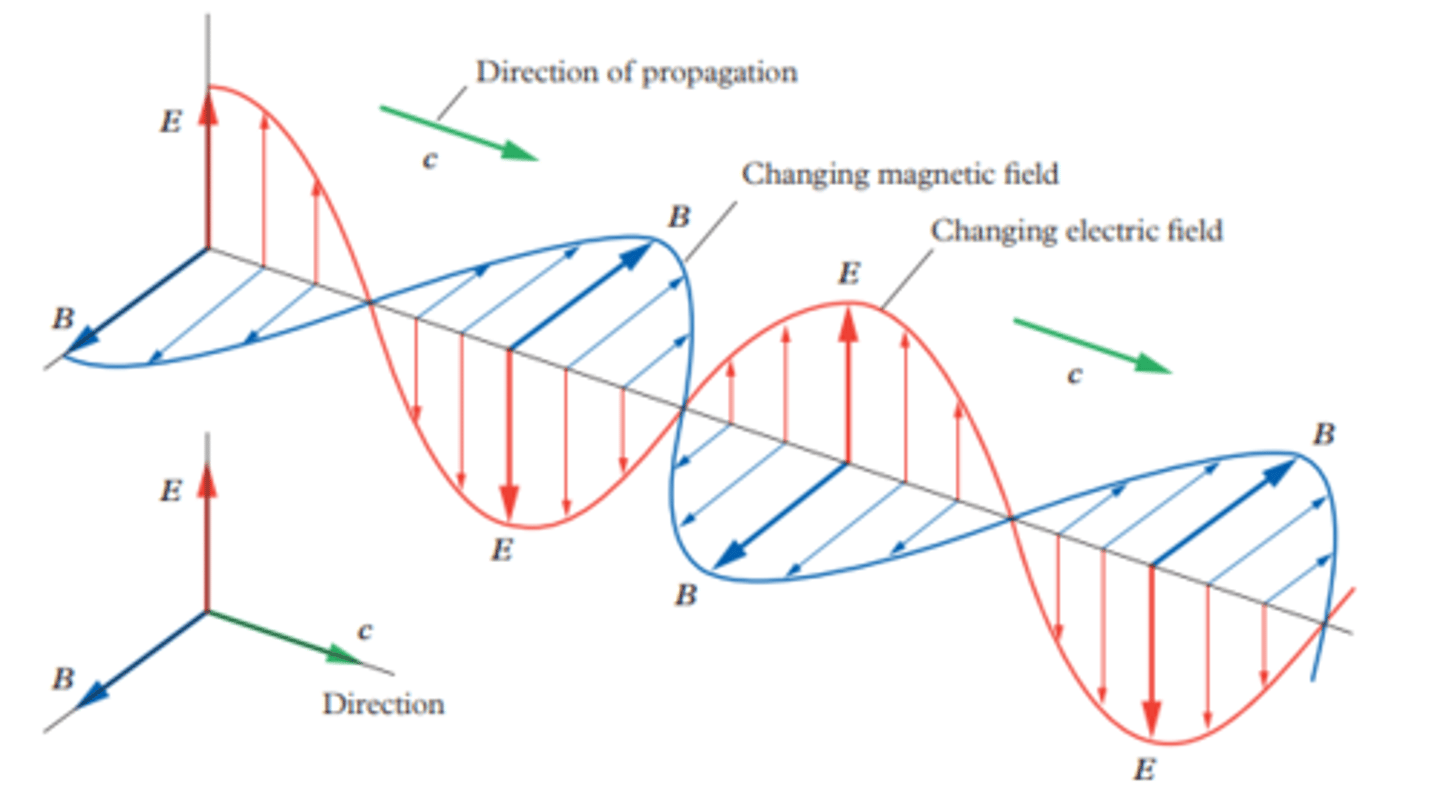
Magnetic field
A region of space in which a magnetic force is experienced. The field is produced from a moving electric charge.
Electric field
A region of space near an electrically charged object within within which a force would be exerted on other electrically charged particles or objects.
electromagnetic radiation
Energy radiating out as synchronized oscillations of electric and magnetic fields, or electromagnetic waves, propagated at the speed of light through a vacuum.
Wave model of light
Uses wave characteristics such as wavelength, amplitude and frequency to describe the behavior of light, such as polarization, interference and diffraction.
Limitations of the 'Wave model of light'
The wave model of light has difficulties explaining phenomena such as black body radiation and the photoelectric effect.
Black body
An object that absorbs all radiation falling onto it. It is a perfect a absorber or emitter of radiation.
Black body radiation
the radiation emitted by a perfect black body (a body that absorbs all the radiation that hits it).
Wien's displacement Law
States that the black-body radiation curve for different temperatures peaks a wavelength inversely proportional to the temperature; The higher the temperature of the black-body the lower the wavelength peak will be.
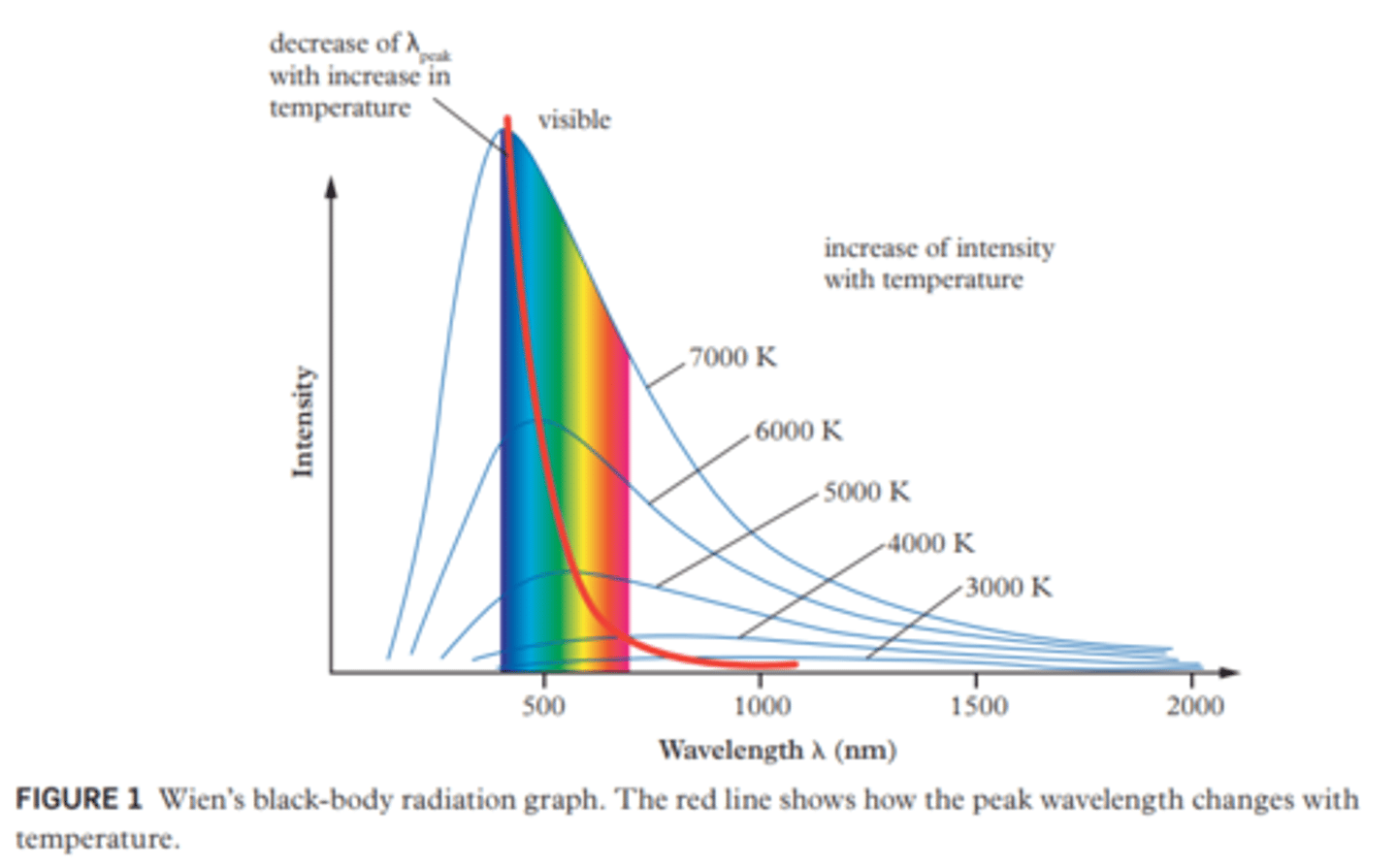
Quanta
The smallest discrete packets of energy of electromagnetic waves, later known as photons.
Discrete
individually separate and distinct.
Planck's constant
A constant used to relate frequency to energy 6.626 * 10^-34.
Planck's equation
Displays the relationship between frequency and energy. It accounts for the quantised nature of light and plays a key role in the understanding of phenomena such as the photoelectric effect and Planck's law of black-body radiation.
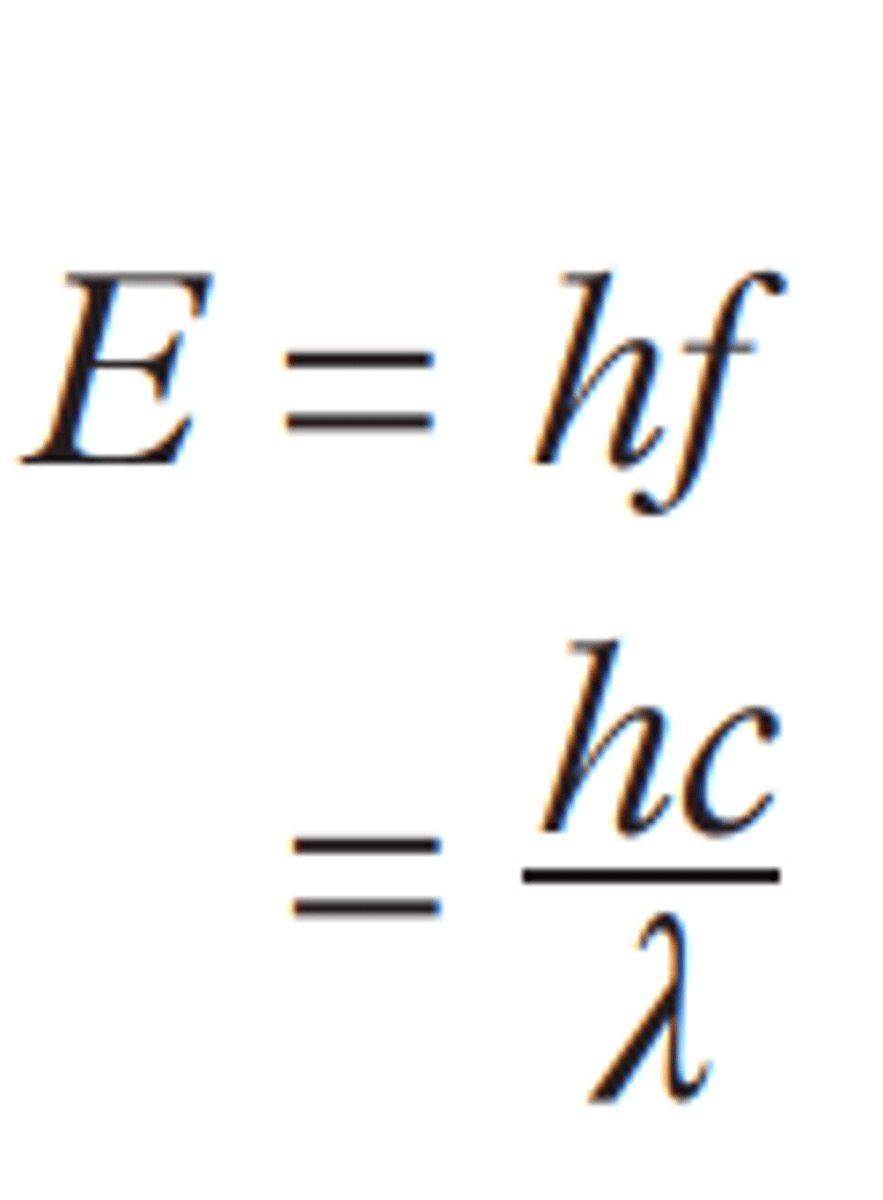
Quantised
Form into quanta.
Photoelectric effect
The emission of electrons (or other carriers) when light shines on a material.
Threshold frequency
The minimum required frequency of a photon that can eject a electron from a surface. It does not matter how intense the light source is, only that the frequency (energy according= to E=h*f) is higher then the threshold.
Photon
A quantum of all forms of electromagnetic radiation.
Stopping potential
The negative potential on the collector at which the photoelectric current becomes zero.
Work function
The minimum energy required to remove a election from a solid.
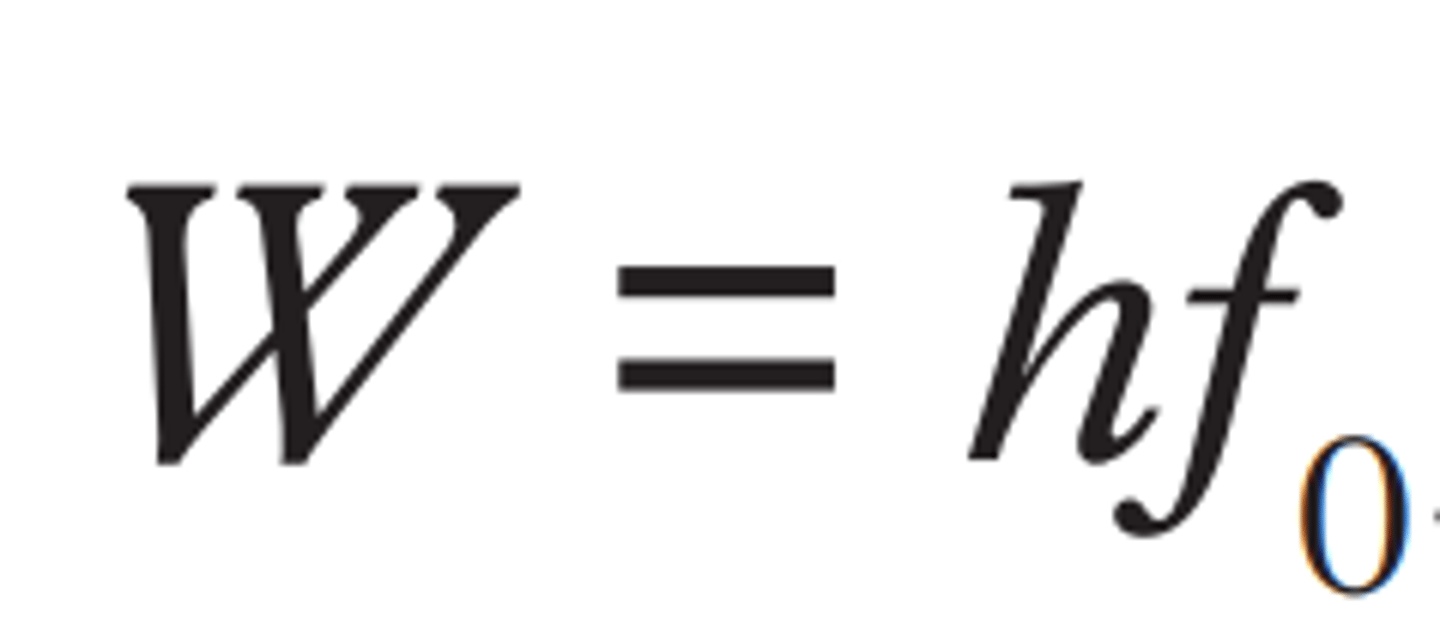
wave-particle duality
Every particle or quanta may be partly described as not only a particle but also a wave.
Rutherford's model of the atom
A small central positively charged nucleus, with negative electrons orbiting around it.
Limitations of Rutherford's model
1. Could not explain how electrons could experience centripetal acceleration, therefore continuously lose energy, and not collapse. Essentially the atom in this model should be unstable.
2. Could not explain the emission lines of the hydrogen spectrum; Cannot explain why certain wavelengths are absorbed, or are emitted in different spectrums.
Bohr's model of the atom
Electron orbit the nucleus in stationary states, with fixed angular momentum and energy,their distance from the nucleus being proportional to their energy. When an electron moves between stationary states, it is accompanied by the emission or absorption of a photon.
Stationary states
angular momentum
For circular motion, the momentum of a particle in which the velocity vector points along the radius of the circular path and is equal to mvr.
Bohr's postulates
1. Electrons in an atom exist in stationary states.
2. Transition between stationary states absorbs or emits electromagnetic radiation.
3. Angular momentum of a stationary electron is quantised.
Balmer's equation
Is used to calculate the wavelength required to make an electron jump a certain amount of orbitals.
Where:
RH = 1.097 * 10^7 1/m
nf = the final orbital the electron was in
ni = the intial orbital the electron was from

Limitations of Bohr's model of the atom
1. Spectra of large atoms
2. Relative spectra intensity
3. Hyperfine spectral lines
4. Zeeman effect
5. Stationary states
Note: Initially Bohr's model didn't really solve the instability of the atom due to centripetal force problem. This was solved later by de Broglie.
Electron probability cloud
A theory stating that instead of electrons actually orbiting the nucleus, they could just exist in a stationary position as but the position they are in is unknown, and their is no way of knowing. The only indication of position is the wave like 'cloud' of possible positions. This solved the problem of how an atom could be stable when the electron is under constant centripetal acceleration.

Wave-particle duality for matter
The discovery of the electron probability cloud, and its wave like manner, meant that matter could be similar to light, in that it can display wave and particle characteristics. This lead to the wave-particle duality for matter.
Standard model
A theory describing three of the four fundamental forces in the universe, as well as classifying all known elementary particles.
Elementary particle
A particle that with no substructure, and thus not composed of other particles.
Higgs boson
An elementary particle in the standard model that acts as a 'force carrier' for the Higgs fields - field that pervades the universe and is responsible for giving certain elementary particles mass. It is similar to the way a photon is a force carrier for the electromagnetic field
Particle zoo
A term used to describe the large variety of particles
Antiparticle of matter
A particle that has the same mass, but opposite charge and spin (dw about spin).
Antiproton
The antiparticle of the proton.
Has an electric charge of -1e.
Any collision with a proton causes both to be annihilated.
Antimatter
Matter composed of the anti particles that constitute ordinary matter
Quark
subatomic particles governed by the strong nuclear forces that constitute hadrons;
there are sic quarks in the standard model
Up +2/3e , Down -1/3e
Charm +2/3e, Strange -1/3e
Top +2/3e, Bottom -1/3e
Antiquark
Same mass as a quark but with opposite charge and spin (dw about spin).
Antiup -2/3e , Antidown +1/3e
Anticharm -2/3e, Antistrange +1/3e
Antitop -2/3e, Antibottom -+1/3e
Generation
A division of the elementary particles according to the Standard Model. There are three generations;
1st Top/Down,
2nd Charm/Strange,
3rd Top/Bottom.
Hadron
Particle composed of quarks and gluons
Gauge bosons
The four mediating particles that govern particle interaction. Their name and respective force they mediate are;
Photon - Electromagnetic force
Gluon - Strong nuclear forces
W&Z - Weak nuclear force
Baryon
A subatomic particle that is the combination of 3 quarks or 3 anti-quarks (if three anti-quarks it is a anti Baryon). Either has a charge of 1e, -1e, or 0e.
Meson
A subatomic particle comprised of 1 quark and one anti-quark. Are incredibly unstable, do do the quark and anti-quark destroying each other.
Leptons
A class of elementary particles, of which there are six of them. They do not form composite particles, that is, they are not building blocks (unlike quarks).
They have either one unit of electric charge or are neutral. The six types of leptons are;
Electron -1
Electron neutrino 0
Muon -1
Muon neutrino 0
Tau -1
Tau neutrino 0
All 6 leptons also have respective anti-leptons, where as standard, their charges are opposite.
Baryon number
A number describing the contents of a baryon. If the number is 1, it is comprised of quarks, if the number is -,1, it is comprised of anti-quarks, and if the number is 0 it is comprised of both (meson) or neither (lepton).

Lepton number
A number describing the nature of elementary particle reaction. The number represents the difference between the number of leptons and anti-leptons in a elementary particle reaction.

Conservation of Baryon and lepton number
That in any interaction the baryon and lepton number is conserved.
Feynman diagram
The graphical representation of particle interaction. With time along the horizontal axis and space long the vertical axis.
Representation of particle motion
Straight-line arrows in the direction of time, with the respective letter or character of the particle indicated.

Representation of antiparticle motion
Straight-line arrows in the opposite direction of time, with the respective letter or character of the particle indicated.

Representation of gauge bosons
Wiggly lines, with the respective letter or character of the type of boson indicated.

Vertex
The point where particles interact. At the vertex they will emit or absorb new particles, deflecting one another or changing type. Vertices are represented by a dot, or the point where the three lines meet.

Vertex - location
For external particles (real particles) If the particle is incoming, the vertex will be to the right of the particle, if it is outgoing, the vertex will be to the left of the particle. For internal lines (representing virtual particles) the vertices are at both ends.

Electron - Electron interaction
As two electrons move closer (shown by the distance on the space axis decreasing between them) the electrostatic repulsion between the two negative charges gets stronger. This causes them to slow down as they near each other. Once close enough they exchange a photon, which repels each electron away from the other.
Electron - positron interaction
Symmetry
When a particle interaction is subjected to to a certain operation and it appears exactly the same after the operation.
Charge-reversal symmetry
Interactions that are not affected if all charges are swapped
Time-reversal symmetry
And interaction that looks the same if the flow of time is reversed (products become reactants, reactions become products).
When solving problems involving gravity and motion, how do you know whether gravity should be positive or negative?
If the object is going against gravity (upwards) then it will be negative. If the object is going with gravity (downwards) then it will be positive.
when analysing a graph, what do you say about it?
Describe the trend (e.g "positive linear trend" or "quadratic relationship/ indirectly proportional") and justify it with the r-squared value.
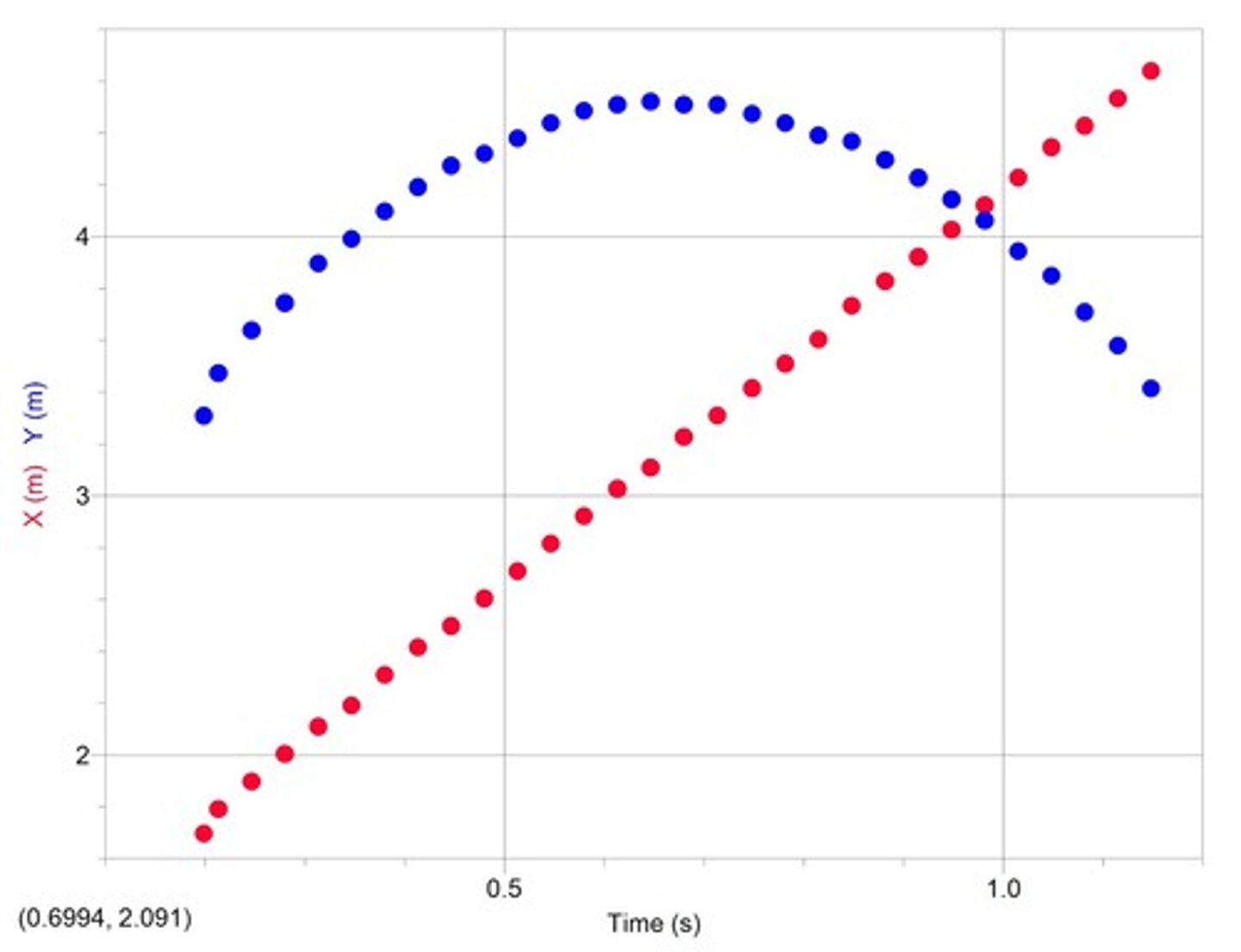
Define the normal force
A force acting perpendicular to the surface.

How do you calculate the force of gravity on an object?
F = mg
What is Newton's first law?
An object stays at rest unless acted on by another force (This is called inertia).
What is Newton's second law?
F=ma
What is Newton's third law?
Every action has an equal and opposite reaction.
What is friction?
A force that opposes motion
What is the net force?
The sum of all forces acting on an object
What does it mean when the net force equals zero?
There is no acceleration. The object is either not moving or travelling at a constant velocity.
What is tension?
The force exerted by a rope, cable, chain, etc.
If an object is being hoisted upwards, with an acceleration by a chain, how do you calculate the tension in the chain?
Fₜ = Fₙₑₜ + Fw
where Fₙₑₜ = ma (acceleration of the object moving upwards)
What is a force applied at an angle?
An object on a FLAT surface being pulled by a rope/cable/chain at an angle.
How do you calculate the normal force when there is a force applied at an angle?
The vertical force exerted by the rope/cable/chain decreases the normal force.
So, Fₙ = Fw - Fᵥ
When an object is on an incline, how do you calculate the applied force or force going downwards?
Fₐ = mgsinθ -Ff (if friction is present) down incline
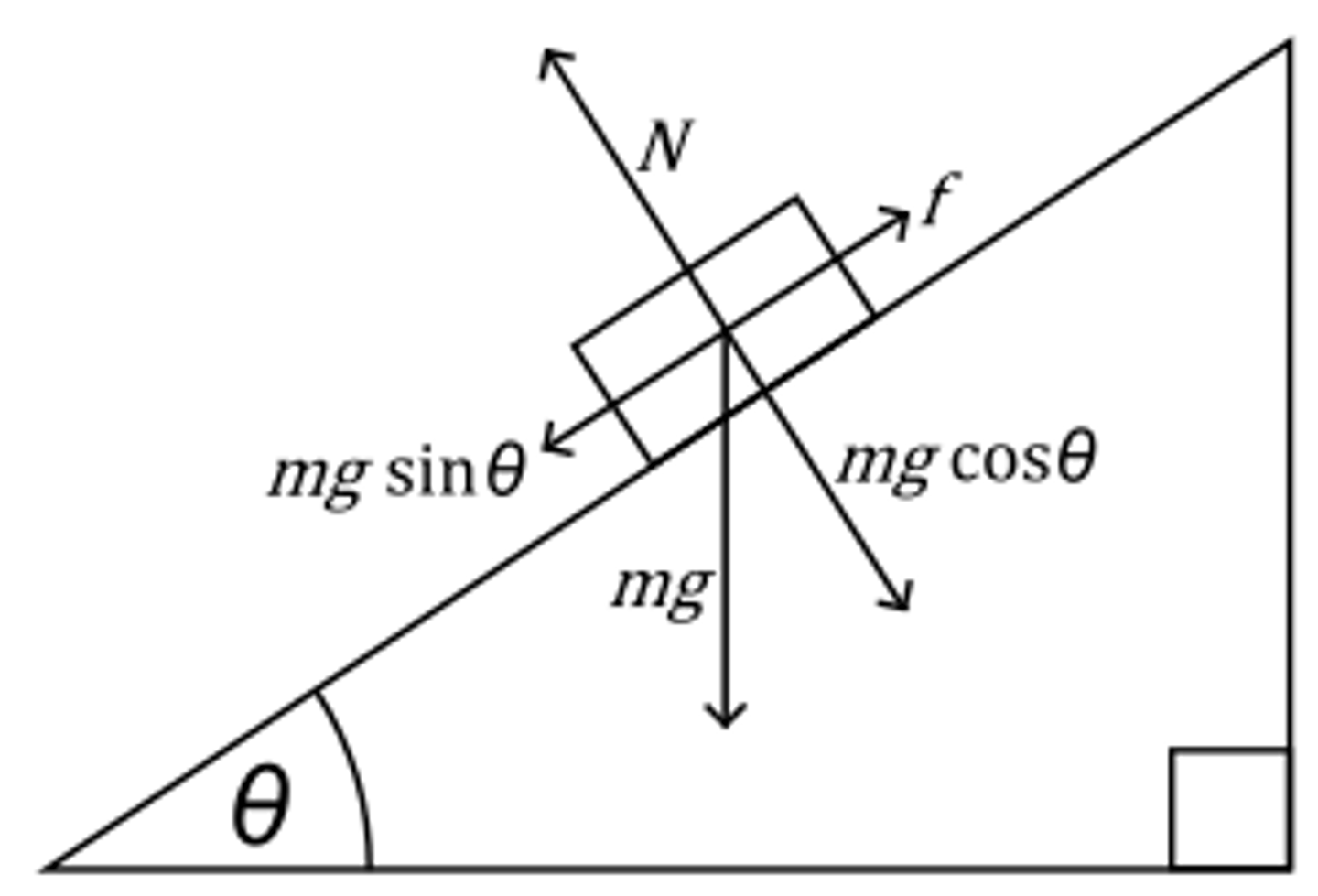
How do you calculate the force of friction?
Ff = mgsinθ - Fₐ
OR
Ff = µ Fₙ
where µ is the coefficient of friction.
How do you calculate the normal force of an object on an inclined plane?
Fₙ = mgcosθ perpendicular to incline
How do you calculate the tension in a rope pulling an object up an incline at a constant speed?
Since the objects is travelling at a constant speed, a=0. Therefore, Fₙₑₜ = 0
So, Fₜ = mgsinθ